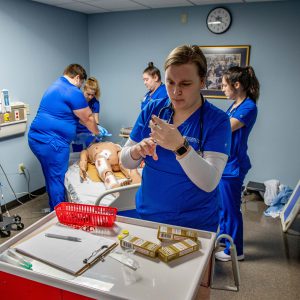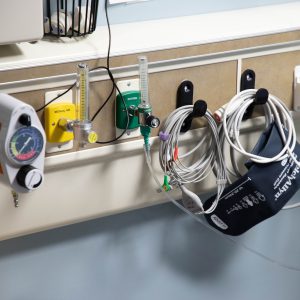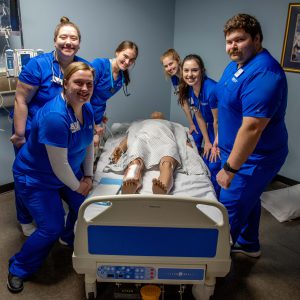
At the CUW School of Nursing, students put their skills to the test through rigorous simulation drills in our top-notch simulation labs.
Editor’s note: A version of this story first appeared in the spring 2023 edition of Hearts Together, a magazine publication of Concordia University Wisconsin and Ann Arbor.

Perhaps the first thing to understand is the difference between a nursing “skills lab” and a “simulation lab.” Both are important, and the CUW School of Nursing has great facilities in each category. As the name suggests, a skills lab is where students learn how to do things like start an IV or assess vital signs. High-tech mannequins are involved, but the emphasis is on learning in a low-pressure, hands-on environment with plenty of help available as you need it.
A simulation lab, on the other hand, is more about high stakes and high pressure. The scenes they’re acting out have life-or-death consequences and are made to feel as real as possible. In the current edition of Hearts Together magazine, a team of senior nursing students is pictured doing a “code” drill on a mannequin in a very realistic setting. At one point, their procedure is interrupted by an instructor pretending to be the patient’s very concerned wife.

If it can happen in the real world, it just might happen in a simulation.
“Simulations are set to challenge students critical thinking and allow for exploration of nursing assessments, interventions, and psychosocial care of a patient or group of patients,” says Nursing Simulation Lab Coordinator Tina Gaffney. These experiences prepare students for the many times during their careers they will need to think and act in critical situations.
“Students in the traditional undergraduate nursing program attend simulations starting their sophomore year and continue through their senior year,” she adds. “Each simulation is set up to mimic what they may see in their clinical experiences for that semester and includes education based on their learning in theory classes.”
Progressively challenging

As students gain knowledge and experience, the simulated scenarios they face become more complex and difficult. Sophomore students, for instance, include fairly basic patient care, including a lot of assessment skills. At all levels, the simulations are conducted in one of three simulated patient rooms.
As juniors, things get more complex. The mannequins get more detailed, even sometimes wearing makeup to simulate how a patient might present with different symptoms. Students start using skills such as starting an IV, inserting a Foley catheter, or performing tracheotomy care.
When students become seniors, the simulations become as real as possible. Parameters or patient status can change suddenly, and students have to make critical decisions. Isolation care is common. They also throw in variables such as language barriers or mental health conditions. They also may have to instruct the patient (who is voiced from the control room) on important home care of follow-up procedures.
Interactive high-tech
Everything that goes on is managed and monitored remotely from an interactive high-tech control room. Patient care decisions—for better or worse—can affect outcomes in real time. Patient status can change in an instant, sometimes without any warning.
In all cases, students are given a basic briefing on what they’re about to walk into—but no more than what they might know in a real-world situation. What might happen once they’re at work, however, is always uncertain. Highly trained and well-credentialed facilitators oversee the whole process.

“Facilitators are educated in simulation-based education pedagogy, having training in pre-brief, debrief, and areas of facilitation of simulation education,” Gaffney says. “In addition, all staff in the Concordia Nursing Simulation Lab are members of the INACSL [International Nursing Association for Clinical Simulation in Learning] members and continue education through the annual INACSL Conferences and Center for Learning.”
After each drill, students are debriefed on the experienced. They are asked evaluate their own performance and are given the chance to ask any questions they may have had.
It all adds up to a class of School of Nursing graduates who are more than ready to put their skills to the test in the real world.
“The experiences set the students up for the many times they will need to critically think and act as individuals and inter-professionals in their careers as Bachelor prepared nurses.” Gaffney concludes.
Want in?
The School of Nursing develops nurses ready to excel in today’s challenging health care context. As a nursing student, you will learn to care for people of all ages in both acute care settings and the community. Instructors and classroom experiences blend curricular rigor with a passion for care, a balance that develops you uniquely both to serve with professional excellence and to fulfill your sense of calling as you care and serve throughout your career.
The spring 2023 Hearts Together magazine hit mailboxes in April. View a PDF version of the magazine here. If you are not on our mailing list, but are interested in receiving a free copy, email Jennifer.Hackmann@cuaa.edu.